|
| Myochin Tong Wind Chimes |
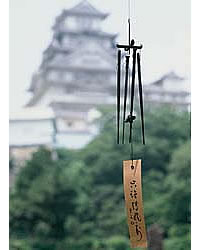 |
The “Myochin
Tong Wind Chimes” creates a clear and subtle sound.
These tongs were originally used as charcoal tongs in the
tea ceremony, and now the prefectural authority recognizes
this traditional craft. The Myochin family, who manufactured
armor for the Himeji feudal government, invented these chimes.
It is said that Rikyu Sen, founder of the tea ceremony, also
enjoyed using these tongs.

|
| [ Top ] |
|
| Himeji Hariko |
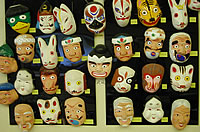 |
“Himeji
Hariko” has been made out of old paper, such as accounting
books, since the Edo period. All works, like fortune masks
and toys, are made by hand.
[ Large view ] |
| [ Top ] |
|
| Himeji Tops |
 |
“Himeji
Tops” have a 100-year history. They are very stable
and spin for a long time. They are often given as gifts to
boys in order to encourage them to become independent, as
symbolized by the tops.
[ Large view ] |
| [ Top ] |
|
| Himeyama Dolls |
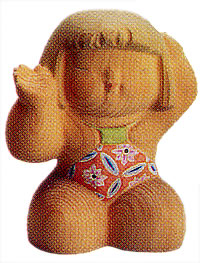 |
“Himeyama
Dolls” are carved in a way to emphasize the beauty
of the grain in plain wood. Once you hold the doll in your
hands and look into its face, you will be filled with warmth
and tenderness. |
| [ Top ] |
|
| White Leather |
 |
White
Leather is tanned with skills imported from the continent.
Leather was once used for armor and gear for horses. Now
used as stationary containers, wallets and handbags, local
leather goods enjoy a good reputation.
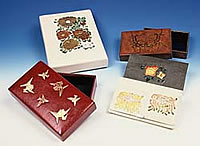
|
| [ Top ] |
|
| Shosha
Lacquer Ware |
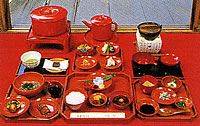 |
Two
traditional craft works have been revived recently: “Shosha
Lacquer Ware”, handed down at the Engyoji Temple of
Shosha,...
[ Large view ] |
| Shirasagi
Dyed Cloth |
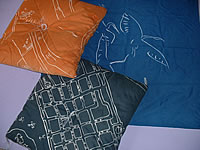 |
...and “Shirasagi
Dyed Cloth”, given as
a gift by Hideyoshi Toyotomi to Nobunaga Oda. Both craft
works are popular as souvenirs.
|
| [ Top ] |
|
| Sweets and Cakes |
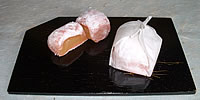
|
As
Himeji grew into a castle town, the tea ceremony became popular
among samurai and business people and also became part of
their etiquette. Therefore, many sweets and cakes for tea
ceremony were created. We still have a cake that was named
by Sunnoh Kawai, the Vice Lord of the Himeji feudal government
in late Edo period. |
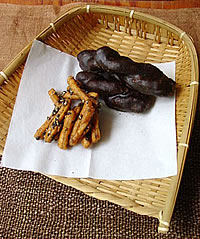 |
Local
samurai, who had studied at Nagasaki and learned the technique
from the Dutch people there, invented these sweets. An oily
western taste mixed with raw sugar and granulated sugar are
popular.
[ Large view ] |
| [ Top ] |
|
| Gozasorou |
 |
“Gozasorou” is
the most popular sweet here in Himeji. It is a common sweet,
and it is called “Imagawa-yaki” in Eastern Japan
and “Kaiten-yaki” in Western Japan. It is filled
with red-bean paste. |
| [ Top ] |
|
| Maedore Cuisine |
 |
Because
the Harimanada Sea is nearby you can enjoy a variety of seafood. “Maedore
Cuisine” with fresh mackerel, sea bass, flatfish and
other seafood makes a perfect dinner. Anago eel called Densuke
is well known here.
[ Large view ] [ Link ]
|
| [ Top ] |
|
| Kamaboko |
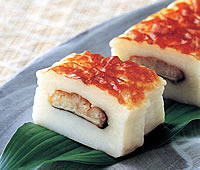 |
Kamaboko
(fish cake) is also popular in this area. The taste of fresh
fish is held inside the cake, and you do not need any seasoning
on top. You can sample and buy a wide variety of kamaboko
products at the Yamasa Kamaboko visitor
center just north
of Himeji.
[ Large
view ] [ Link ] -  |
| [ Top ] |
|
| Somen Noodles |
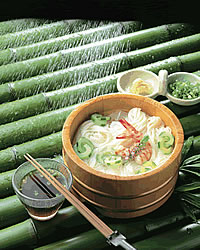 |
“Somen
Noodles” are famous in this local Banshu area, and
they are sold nationwide under the names of "Himegoryo" and “Ibonoito”.
They are made from quality ingredients: water from Ibo River,
salt from Ako and high quality wheat. The noodle has a fine
texture and smooth taste. You can eat
somen cold, stir-fry
it with vegetables, or have it in miso soup. |
| [ Top ] |
|
| Sake |
 |
Himeji
is proud of its Sake, and there are seven sake makers in
the city. The best sake rice, “Yamada-nishiki”,
is locally grown, and water coming from the Chugoku mountains
is very suitable for making sake. We have a long tradition
of sake makers. |
| [ Top ] |
| We have introduced goods and souvenirs
from the Himeji area. We highly recommend that you take
some home to your family, friends and for yourself. |
| |

